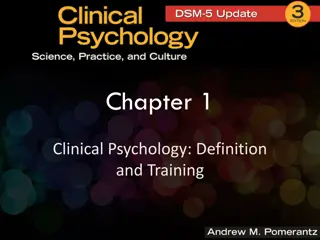Research Methods in Psychology
Learn about event and time sampling in observational studies, explore the scientific nature of biological psychology, understand the practical justifications for using animals in psychological studies, discover real-life applications of cognitive psychology, examine the role of social psychology in social control, and delve into socially sensitive research and theories of obedience.
Download Presentation

Please find below an Image/Link to download the presentation.
The content on the website is provided AS IS for your information and personal use only. It may not be sold, licensed, or shared on other websites without obtaining consent from the author.If you encounter any issues during the download, it is possible that the publisher has removed the file from their server.
You are allowed to download the files provided on this website for personal or commercial use, subject to the condition that they are used lawfully. All files are the property of their respective owners.
The content on the website is provided AS IS for your information and personal use only. It may not be sold, licensed, or shared on other websites without obtaining consent from the author.
E N D
Presentation Transcript
What is the difference between event and time sampling in an observational study? psychlotron.org.uk
How scientific is biological psychology? psychlotron.org.uk
What are the practical justifications for using animals in psychological studies? psychlotron.org.uk
Describe three ways that cognitive psychology has been applied to real-life problems. psychlotron.org.uk
How can social psychology be used for social control? psychlotron.org.uk
What do we mean by socially sensitive research ? psychlotron.org.uk
How does social impact theory explain obedience? psychlotron.org.uk
Give three conclusions of Sherif et al (1954) psychlotron.org.uk
What does a measure of dispersion tell you? psychlotron.org.uk
Why might a researcher prefer using a structured interview? psychlotron.org.uk
What are three ethical problems with Milgram s obedience studies? psychlotron.org.uk
Is it true that authoritarianism makes a person more prejudiced? psychlotron.org.uk
Why should we not refer to Sebastian & Hernandez-Gil (2012) as an experiment? psychlotron.org.uk
Which working memory components are involved in following a set of directions someone has given you? psychlotron.org.uk
Why is the standard deviation a better measure of dispersion than the range? psychlotron.org.uk
Explain how you could shape the behaviour of a dog to use a pedal bin. psychlotron.org.uk
Explain two reasons why you cannot draw causal conclusions from a correlational study. psychlotron.org.uk
What is your key question for learning theory? psychlotron.org.uk
How true is it that cognitive psychology cannot be used for social control? psychlotron.org.uk
Give two reasons why it is unwise to rely on case studies of brain injury patients to evaluate models of memory. psychlotron.org.uk
How can we reduce socially desirable response bias? psychlotron.org.uk
When would it be better to use a fMRI scan than a PET scan? psychlotron.org.uk
How does Batesons cube help researchers decide whether an animal study is justified. psychlotron.org.uk
What is spontaneous recovery? psychlotron.org.uk
How has cognitive psychology developed since the 1960s? psychlotron.org.uk
How might testosterone be involved in aggression? psychlotron.org.uk
When would it be appropriate to use a Mann-Whitney U test? psychlotron.org.uk
What evidence is there that testosterone does not directly influence aggression? psychlotron.org.uk
What ethical issues might be raised by a covert observational study? psychlotron.org.uk
What are the strengths of Banduras studies? psychlotron.org.uk
Describe the process of neural transmission. psychlotron.org.uk
Give an example of socially sensitive research in cognitive psychology. psychlotron.org.uk
What effect do situational factors have on prejudice? psychlotron.org.uk
Give a similarity and a difference between questionnaires and interviews. psychlotron.org.uk
Why does reducing prejudice matter for society? psychlotron.org.uk
Is social psychology reductionist? psychlotron.org.uk
Give two reasons why it is reasonable to generalise from animals to humans in biopsychological research. psychlotron.org.uk
What is dissent? psychlotron.org.uk
How does social identity theory explain prejudice? psychlotron.org.uk
When would it be appropriate to use a Wilcoxon Sign Ranks test? psychlotron.org.uk
What is an order effect and what should you do about them? psychlotron.org.uk
Explain one reason why methadone therapy should be used with drug addicts. psychlotron.org.uk
Explain three ethical issues raised by Raine et al (1997) psychlotron.org.uk
How scientific is social psychology? psychlotron.org.uk
Explain a strength and a weakness of Raine et al (1997). psychlotron.org.uk
What do we mean by controlling a variable? psychlotron.org.uk
Explain three reasons why social psychology might not be considered scientific. psychlotron.org.uk
Give a similarity and a difference between social identity theory and realistic conflict theory. psychlotron.org.uk
When would it be appropriate to use a Chi Squared test? psychlotron.org.uk
How do we know that there are different types of LTM? psychlotron.org.uk























